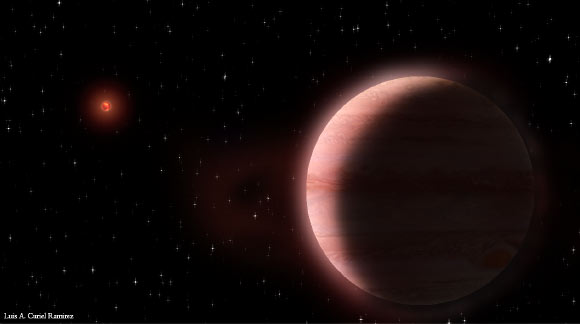Astronomers using NSF’s Very Long Baseline Array, a continentwide system of 10 radio telescope antennas located between Hawaii and Puerto Rico, have detected a giant exoplanet in orbit around the ultracool dwarf TVLM 513-46546 (TVLM 513 for short). This is the first astrometric detection of a planet at radio wavelengths. The presence of this Saturn-like planet on a close circular orbit around tiny star represents a challenge to the current planet formation theory.
Source: Sci News
TVLM 513 is an M9-dwarf star located 35 light-years away in the northern constellation of Boötes.
Otherwise known as 2MASS J15010818+2250020, the star has a mass of just 0.06-008 times that of our Sun.
The newfound planet is a gas giant between 0.35 to 0.42 times the mass of Jupiter.
It orbits its parent star once every 221 days at a distance of only 0.3 AU (astronomical units).
Dubbed TVLM 513b, the alien world was discovered using the so-called astrometric technique.
“This technique involves tracking the star’s actual motion in space, then detecting a minuscule wobble in that motion caused by the gravitational effect of the planet,” explained Dr. Salvador Curiel from the National Autonomous University of Mexico and colleagues.
“The star and the planet orbit a location that represents the center of mass for both combined.”
“The planet is revealed indirectly if that location, called the barycenter, is far enough from the star’s center to cause a wobble detectable by a telescope.”
“The technique is expected to be particularly good for detecting Jupiter-like planets in orbits distant from the star. This is because when a massive planet orbits a star, the wobble produced in the star increases with a larger separation between the planet and the star, and at a given distance from the star, the more massive the planet, the larger the wobble produced.”
The astronomers observed TVLM 513 using the Very Long Baseline Array (VLBA). They also used data from the VLBA archive.
The extensive analysis of the data revealed a telltale wobble in the star’s motion indicating the presence of a massive planet.
“Giant planets, like Jupiter and Saturn, are expected to be rare around small stars like this one, and the astrometric technique is best at finding Jupiter-like planets in wide orbits, so we were surprised to find a lower mass, Saturn-like planet in a relatively compact orbit,” Dr. Curiel said.
“We expected to find a more massive planet, similar to Jupiter, in a wider orbit.”
“Detecting the orbital motions of this sub-Jupiter mass planetary companion in such a compact orbit was a great challenge.”
The team’s paper was published in the Astronomical Journal.
Source: Sci News

































Leave a Comment
You must be logged in to post a comment.